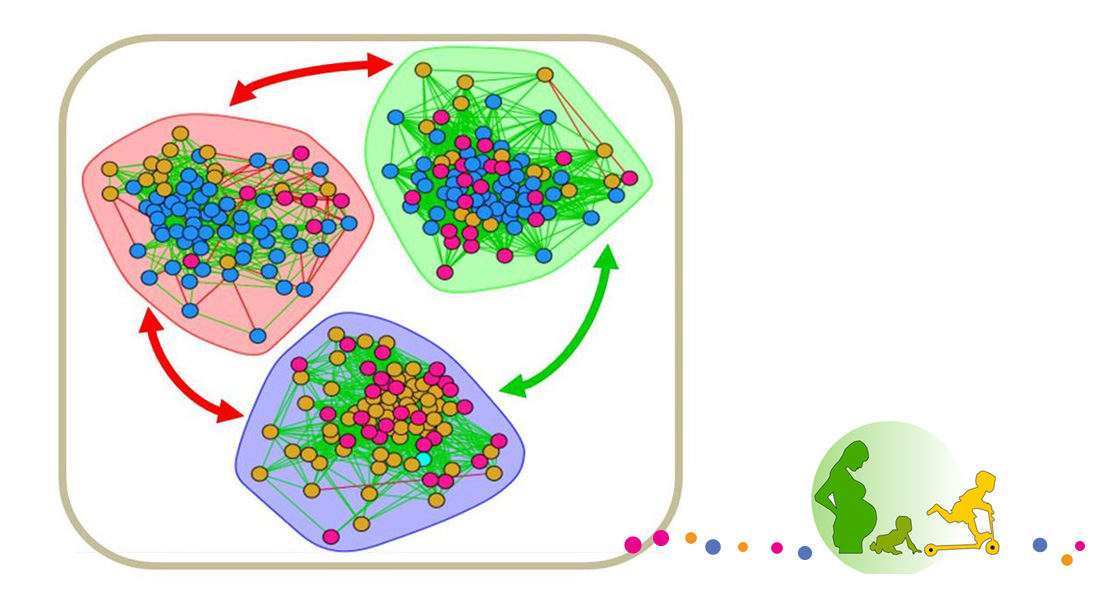Deciphering the causal mechanisms linking the early life microbiome and common chronic inflammatory diseases
The overall aim in this project is to decipher the causal mechanisms linking the early life microbiome and common chronic inflammatory diseases.

To do this, we aim at determining the full metagenome from gut and airways - before the onset of disease- and map the compositional-, functional- and metabolic potential of the microbiome to unravel the extrinsic mechanisms that determine the transition from health to chronic disease.
Deciphering the causal mechanisms linking the early life microbiome and common chronic inflammatory diseases
Groundbreaking novel results from the COPSAC2010 cohort suggest association between the gut microbial composition and the first year of life and the later risk of asthma. Thus, the microbiome may be an intermediary player in the interaction between the host and its environment in the extrinsic mechanisms that determine the transition from health to chronic disease.
Background and aim
The incidence of asthma and other chronic inflammatory diseases has more than doubled over the last century in the westernized world. It is a common working hypothesis that early microbiome interacts with the child's genetic makeup and that inappropriate microbiome composition can affect host immune maturation, thereby initiating a trajectory to immune mediated diseases such as asthma.
The overall aim in this project is to decipher the causal mechanisms linking the early life microbiome and common chronic inflammatory diseases. To do this, we aim at determining the full metagenome from gut and airways - before the onset of disease- and map the compositional-, functional- and metabolic potential of the microbiome to unravel the extrinsic mechanisms that determine the transition from health to chronic disease.
The COPSAC2010 cohort includes longitudinal deep clinical phenotyping, exposure assessment and biological samples from pregnancy through childhood. This provides a unique opportunity for deciphering the causal mechanisms linking the early life microbiome and common chronic inflammatory diseases facilitating determination of the healthy microbiome in early life and potentially also the possibility to identify key collaboromes (interspecies dependent microbiome consortia) which facilitate healthier composition.
Gains and perspectives
If we succeed, this project could lay the foundation for understanding microbiota roles in development of chronic inflammatory diseases and potentially lead to novel prevention strategies and targeted, efficient microbiota manipulation in groups at risk.
Project owner
Professor Hans Bisgaard
Head of Copenhagen Propective Studies on Asthma in Childhood (COPSAC), DSI Dansk BørneAstma Center, Gentofte Hospital.

 Professor Søren Johannes Sørensen
Professor Søren Johannes Sørensen
I am currently team leader for a group of 12 scientists, 11 phd’s, three technicians and ten master students applying molecular techniques in microbial ecological studies at the Section of Microbiology. My research focuses on social interactions in microbial populations. My group’s studies evaluate the extent of genetic flow within natural communities and their response to environmental perturbations.
The section houses state of the art culture independent experimental infrastructure that enables us to examine how microbes interact at a scale that is relevant for such small organisms and to examine and identify the roles of the individual species that contribute to these interactions.
We investigate how microbes work together in in their natural state such as biofilms and the effect this has on microbial communities in in vivo systems such as human or animal gut, soil, or phase change communities. These are related to our in vitro model systems such as our bioflux biofilm system where we can evaluate our findings and examine phenomenon such as horizontal gene transfer or emergent community properties and evolutionary strategies. To do so we use techniques such as high throughput sequencing, flow cytometry and ultra-high resolution bioimaging or confocal microscopy and microbial reporter systems.
The pioneering work of the section has had been recognized for its impact in diverse areas in which microbial interactions are critical. These include, Soil biodiversity and bioremediation, the role of horizontal gene transfer, human disease progression, the effects of species diversity in plant animal and environmental microbiomes, how microbes interact in evolutionary strategies and the significance of cooperation verses antagonism in microbial systems.
Working in these areas necessitates close collaboration with international scientists from around the world that come to the section and to whom members of the section visit in scientific exchange programs. They span all corners of the globe including Dr. Duncan Veal, Macquarie University, Sydney Australia, Prof A. Spormann, Stanford University, Prof. S. Kjelleberg, University of NSW; Prof. M. Schloter, Helmholtz Zentrum München; and Prof. Md Hans Bisgaard COPSAC back here in Denmark.
These collaborations have helped more than 20 postdocs and 30 past Ph.D. fellows follow their career path both here and around the world to obtain successful positions in both academia and research.
Section of Microbiology

Funded by:
TANDEM Grant from the Novo Nordisk Foundation
Project title:
Deciphering the causal mechanisms linking the early life microbiome and common chronic inflammatory diseases
Project period: 01.08.2017 - 31.07.2021
Contact
 Professor
Professor
Søren Johannes Sørensen
Universitetsparken 15
Building 1, 1st floor
DK-2100 Copenhagen
Email: sjs@bio.ku.dk

